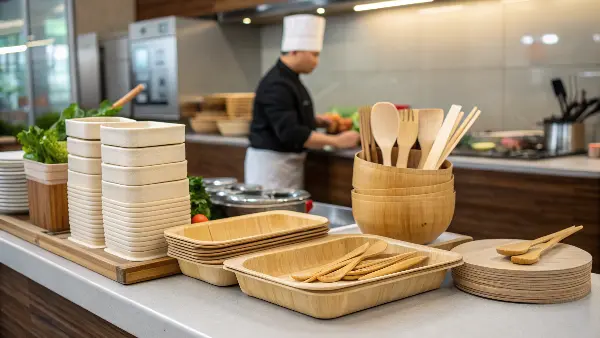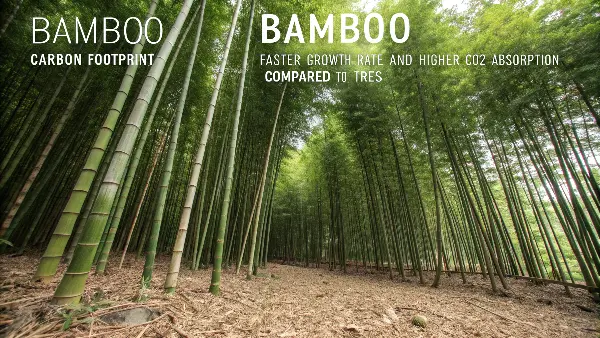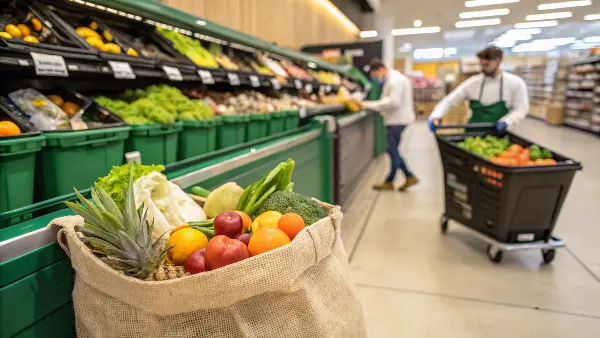The food service industry is under massive pressure to reduce its environmental impact, and its carbon footprint is a huge part of that problem. Traditional packaging, mostly plastic, contributes heavily to emissions and landfill waste. Making a change feels urgent but complex. Switching to sustainable materials like bamboo offers a practical, powerful way to make an immediate difference.
The most direct way bamboo products reduce the food service industry’s carbon footprint is through the plant’s natural life cycle and the product’s end-of-life. Bamboo is a carbon sequestration champion, absorbing more CO2 than trees while growing. It requires minimal resources to cultivate, lowering its agricultural footprint. Finally, its products are biodegradable and compostable, avoiding the massive methane emissions that plastics cause in landfills over hundreds of years.

So, we know bamboo is a green champion. But how does it actually pull this off, and what are the specific ways it benefits not just the planet, but your business as well? Understanding these details is key to making an informed, confident switch to sustainable alternatives. Let’s dig deeper into the real-world impact of this incredible grass.
How does bamboo reduce carbon footprint?
Many businesses want to claim they are "green," but they often lack the details to back it up. This can leave them looking like they are greenwashing, and they miss the chance to tell a powerful story. Understanding the science behind bamboo’s carbon-reducing power gives your environmental claims real substance and credibility with your customers.
Bamboo cuts carbon emissions in three key ways. First, as one of the fastest-growing plants, it absorbs significantly more CO2 from the atmosphere than many trees. Second, its cultivation has a low impact, as it needs no pesticides or fertilizers and very little water. Third, its products replace plastics and are fully biodegradable, preventing long-term landfill pollution and methane release.

To truly appreciate bamboo’s role, we need to look at its entire lifecycle, from the moment it sprouts to the day it decomposes back into the earth. I remember visiting a supplier’s bamboo grove for the first time. The air felt cleaner, and the soil was rich and stable. It was a stark contrast to land cleared for other crops. This visual experience drove home the science for me.
The Carbon Sequestration Powerhouse
Bamboo is not just a plant; it’s a carbon-capturing machine. Its rapid growth is the secret. Some species can grow several feet in a single day. To fuel this growth, bamboo absorbs huge amounts of carbon dioxide from the atmosphere—my research shows it can sequester up to twice as much CO2 per hectare as young forests. At the same time, it releases about 35% more oxygen. This directly counteracts the greenhouse gases warming our planet. Its extensive underground root system, called a rhizome, also traps carbon in the soil, keeping it out of the atmosphere for good.
Low-Impact Cultivation
Modern agriculture is often a major source of carbon emissions due to heavy machinery, fertilizers, and pesticides. Bamboo cultivation is completely different. It’s a highly resilient grass that thrives without human intervention. It requires no chemical fertilizers or pesticides, which are often produced using fossil fuels. It is also very water-efficient, relying mostly on natural rainfall. I’ve seen it grow on marginal lands and steep hillsides where other crops can’t, meaning it doesn’t compete for land needed for food production. This low-input farming model makes its raw material inherently low-carbon.
The End-of-Life Advantage
The story doesn’t end when a bamboo product is made. Its end-of-life is where it delivers one of its biggest environmental wins. A plastic fork will sit in a landfill for 500 years, slowly breaking down into microplastics and potentially leaching chemicals. In contrast, a bamboo fork is fully biodegradable and compostable. In a commercial composting facility, it can break down into organic matter in just a few months, enriching the soil instead of polluting it. This avoids the long-term carbon liability of plastic waste.
| Feature | Bamboo | Traditional Trees | Petroleum-Based Plastic |
|---|---|---|---|
| CO2 Absorption | Very High | Moderate | None (Emits CO2) |
| Growth Speed | 3-5 years to harvest | 20-50+ years to harvest | N/A |
| Farming Inputs | Minimal to none | Can require chemicals | High energy/fossil fuels |
| End-of-Life | Compostable | Recyclable/Biodegradable | Landfill/Recyclable |
| Soil Impact | Improves soil health | Can lead to erosion | Contaminates soil |
How do bamboo products help the environment?
Reducing your carbon footprint is a great goal, but a truly sustainable business aims for a wider positive impact. If you only focus on carbon, you might miss other key areas like waste reduction and biodiversity protection. The good news is that bamboo products offer a holistic solution that benefits the environment in multiple ways.
Bamboo products help the environment by directly replacing plastic and wood. This reduces plastic pollution in our oceans and lessens the demand for deforestation. Because bamboo is a self-regenerating grass, harvesting it doesn’t kill the plant, which preserves soil integrity and wildlife habitats. Its biodegradable nature means it returns to the earth, avoiding the chemical pollution caused by plastics.

When sourcing for clients, I always emphasize that their choice of material sends a ripple effect through the entire ecosystem. It’s not just about what the product is made of, but also what it isn’t made of. Every bamboo cup used is one less plastic or styrofoam cup that could end up polluting a waterway or harming an animal. This is a powerful and simple truth.
A Viable Solution to Deforestation
Many paper products used in food service, like cups and containers, come from wood pulp. This contributes to deforestation, which destroys critical habitats for countless species and disrupts ecosystems. Bamboo offers a fantastic alternative. Technically, it’s a type of grass, not a tree. When a bamboo stalk is harvested, the root system remains intact and quickly sends up new shoots. This means bamboo groves regenerate on their own without needing to be replanted. Choosing bamboo helps protect our world’s precious forests and the biodiversity that depends on them.
Directly Combating Plastic Pollution
Single-use plastic is one of the most visible environmental problems we face. We’ve all seen the heartbreaking images of plastic waste choking our oceans and harming marine life. Bamboo products are a direct and practical weapon in this fight. Bamboo cutlery, straws, plates, and takeout containers can replace their plastic counterparts one-for-one. Since they are fully biodegradable, even if they end up in the environment by accident, they will break down naturally over a short period, unlike plastic, which persists for centuries.
Improving Soil and Water Health
The environmental benefits of bamboo start right in the ground. Its dense network of roots and rhizomes is incredible for the soil. It holds the soil together, which dramatically reduces erosion from rain and wind. I’ve spoken with farmers who use bamboo on hillsides specifically for this purpose. This strong root system also improves the soil’s ability to absorb and retain water. This helps prevent water runoff, which can carry pollutants into rivers and streams, and it recharges groundwater tables. It’s a quiet hero, working beneath the surface to create a healthier local environment.
What are the advantages of bamboo food packaging?
As a food service professional, you know that eco-friendly packaging must also be practical, safe, and reliable. It’s a real problem when you make a sustainable choice, but the product fails. Soggy containers, leaky cups, or materials that can’t handle heat create bad customer experiences. The ideal solution has to check all the boxes: green, functional, and safe.
Bamboo food packaging is a star performer. It is strong, durable, and naturally resistant to heat and grease, making it perfect for both hot and cold foods. It’s inherently antimicrobial and requires no chemical liners, ensuring food safety. Furthermore, its natural, elegant appearance enhances brand image, appealing directly to eco-conscious consumers, while its light weight helps reduce shipping costs and emissions.

Selecting the right packaging is a major decision. I’ve worked with many brands like yours, and the ones who succeed are those who find materials that align with their values without compromising on quality. Bamboo consistently comes out on top because it delivers on both fronts. It’s not just a substitution; in many ways, it’s an upgrade.
Superior Performance and Versatility
One of the biggest concerns when moving away from plastic is performance. Many eco-friendly options just don’t hold up. Bamboo is different. Bamboo fiber is naturally strong and stiff, so bamboo plates and cutlery won’t bend or snap under the weight of food. Bamboo containers are grease and leak-resistant, and many are safe for use in the microwave. This versatility means you can find a bamboo-based solution for almost anything on your menu, from hot coffee and soup to salads and greasy takeout meals. It’s the reliable workhorse you need in a busy kitchen.
Natural Food Safety
Consumer safety is non-negotiable. Many paper-based food containers require a thin plastic (PE) or chemical (PFAS) lining to make them waterproof, which can be a health and environmental concern. Bamboo has a natural advantage here. The fiber itself contains an antimicrobial bio-agent called "bamboo kun," which makes it naturally resistant to bacteria and fungi. This means many bamboo products, like plates and bowls, don’t need any artificial liners or coatings. This provides peace of mind for you and your customers, ensuring the food is served in packaging that is as clean and natural as possible.
Enhanced Brand Image and Consumer Appeal
Today’s consumers don’t just buy a product; they buy into a brand’s story and values. Using bamboo packaging is a clear, visible signal that your business is committed to sustainability. It has a premium, natural look and feel that plastic just can’t match. I have seen clients get amazing feedback from customers who appreciate the sturdiness and aesthetic of bamboo products. This positive experience builds customer loyalty and reinforces your brand’s eco-conscious identity, which can be a powerful market differentiator.
| Advantage | Description | Benefit to Your Business |
|---|---|---|
| Performance | Strong, heat-resistant, grease-resistant. | Prevents spills and complaints, high versatility. |
| Safety | Naturally antimicrobial, no chemical liners needed. | Ensures food safety, meets consumer expectations. |
| Aesthetics | Natural, premium look and feel. | Enhances brand image, attracts eco-conscious customers. |
| Sustainability | Renewable, compostable, low carbon footprint. | Meets sustainability goals, powerful marketing story. |
How can we reduce our carbon footprint when it comes to food?
Switching your packaging is a fantastic first step, but you probably know that your full carbon footprint is bigger than just containers. It can feel overwhelming to think about areas like ingredient sourcing and operational waste. Ignoring them, however, means you are leaving significant carbon reductions and cost savings on the table. A complete strategy is the most effective approach.
To truly slash your food-related carbon footprint, focus on a three-part strategy. First, source ingredients locally and seasonally to cut down on "food miles" and support your community. Second, implement a system to minimize food waste through smart inventory and composting. Finally, make the high-impact switch to sustainable disposables like bamboo to eliminate plastic’s carbon-heavy lifecycle entirely.

When I consult with businesses aiming for true sustainability, we go beyond just the packaging. We look at the whole system. The goal is to create a virtuous cycle where every choice, from the farm to the fork to the compost bin, is optimized for the lowest possible environmental impact. This approach not only helps the planet but often leads to a more efficient, resilient, and profitable business.
Rethink Your Sourcing Strategy
The term "food miles" refers to the distance food is transported from where it’s grown to where it’s eaten. A huge amount of carbon is emitted from the planes, ships, and trucks that carry ingredients across the globe. You can make a big dent in this by sourcing from local and regional farms whenever possible. Building relationships with local producers not only cuts your carbon footprint but also supports your local economy, provides fresher ingredients, and gives you a great story to tell your customers. Focusing on seasonal ingredients ensures you’re getting produce at its peak freshness and lowest environmental cost.
Tackle Food Waste Head-On
Food waste is a massive, and often overlooked, source of greenhouse gases. When food scraps end up in a landfill, they decompose without oxygen and release methane, a greenhouse gas that is over 25 times more potent than carbon dioxide. A food business can fight this by conducting a waste audit to see what’s being thrown away. Implement smarter ordering systems, offer flexible portion sizes, and find partners to donate safe, unused food. The final step is to compost all remaining organic waste. This is where compostable bamboo packaging becomes a key ally, as it can go right into the compost bin along with the food scraps.
Make the Switch to Sustainable Disposables
This is often the most direct and visible change you can make, and it brings the whole strategy together. The lifecycle of a plastic fork begins with oil extraction, a carbon-intensive process, and ends with centuries in a landfill. The lifecycle of a bamboo fork begins with a carbon-absorbing plant and ends with it becoming nutrient-rich soil. By replacing all your single-use plastics with bamboo and other compostable alternatives, you sever your ties to the fossil fuel industry and create a truly circular waste stream for your business. It’s the final piece of the puzzle for a low-carbon food service operation.
Conclusion
In the end, switching to bamboo products is a powerful and practical move for any food service business. It directly lowers your carbon footprint, reduces plastic pollution, and meets the growing consumer demand for genuine sustainability. It’s a simple change that demonstrates a deep commitment to the environment and creates a significant, positive impact for a greener future.


